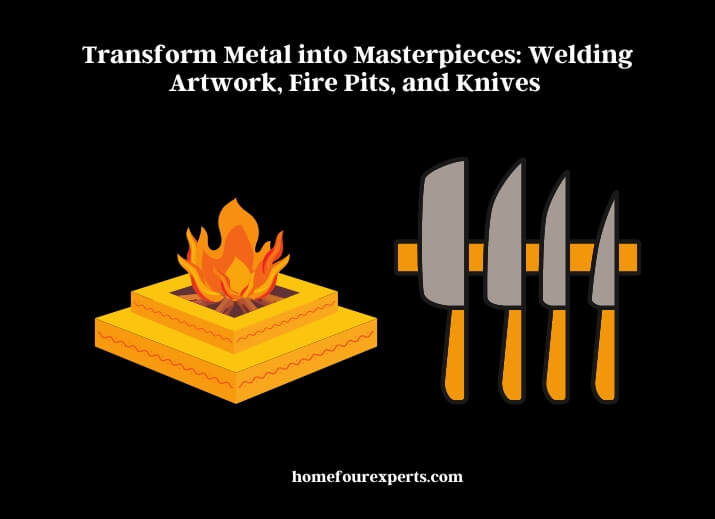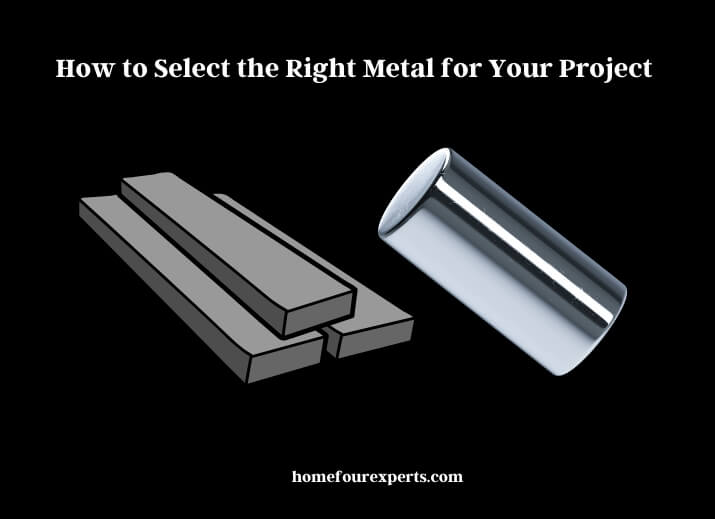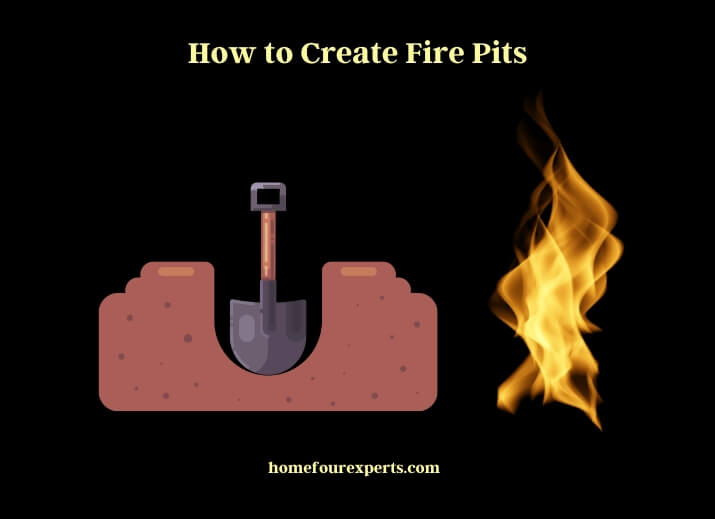Welding is a fascinating process that has been used for centuries to join metals together. Over time, it has evolved into an art form, allowing welders to create intricate and unique pieces that can be both functional and beautiful. Whether you are looking to add some personality to your outdoor living space, create a custom knife, or commission a one-of-a-kind sculpture, welding can transform metal into masterpieces that can last a lifetime.

We will explore the art of welding and how it can be used to create stunning works of art, including fire pits and knives. We will also cover the materials used in welding artwork, safety precautions that should be taken during the welding process, and how to choose an experienced and reputable welding artist.
Welding Techniques for Artwork
When it comes to creating metal artwork, there are several welding techniques that can be used. One of the most popular techniques is MIG welding, which stands for metal inert gas welding. MIG welding is ideal for welding thicker pieces of metal and is known for its speed and efficiency. It uses a spool of wire that is fed through a welding gun and creates a strong, consistent weld.
Another welding technique commonly used in metal artwork is TIG welding, or tungsten inert gas welding. TIG welding is a precise and clean welding method that produces high-quality welds. It is often used for thin or delicate metal pieces and provides greater control over the welding process than MIG welding.
Popular welding technique for metal artwork is stick welding, also known as shielded metal arc welding. This method uses a stick electrode that is covered in a flux coating, which produces a protective gas to shield the weld from contamination. Stick welding is ideal for outdoor welding projects or when welding thicker pieces of metal.
There is plasma cutting, which is a technique that uses a high-temperature plasma torch to cut through metal. Plasma cutting is commonly used for intricate metal designs and can produce clean, precise cuts.
How to Select the Right Metal for Your Project?
Choosing the right type of metal for your welding project is critical to achieving a successful outcome. The type of metal you choose will impact the weldability, strength, and durability of the finished product.

Application
Consider the purpose of the finished product. Will it be exposed to extreme temperatures or weather conditions? Will it be subject to high stress or weight loads? These factors can help determine the type of metal that is best suited for your project.
Weldability
Some metals are more difficult to weld than others. For example, stainless steel requires more skill and expertise to weld than mild steel. Consider the welding experience of the welder and the complexity of the project when selecting a metal.
Strength
The strength of the metal is important, especially for projects that will be under stress or load. Some metals, like titanium, have high strength-to-weight ratios and are ideal for aerospace or automotive applications.
Cost
The cost of the metal can also impact your decision. Some metals, like copper or brass, can be expensive, while others, like steel or aluminum, are more affordable.
Availability
Make sure the metal you choose is readily available in the required size and shape. Custom-cut metals can be more expensive and may require longer lead times.
Common metals used in welding projects include steel, aluminum, stainless steel, copper, brass, and titanium. Work with an experienced welder who can guide you in selecting the right metal for your project based on these factors.
Essential Welding Tools and Equipment
Welding requires a variety of tools and equipment to ensure a successful outcome. Here are some of the essential tools and equipment needed for welding:
- Welding machine: The welding machine is the heart of the welding process. It is the tool that generates the heat necessary to melt the metal and create the weld. There are several types of welding machines, including MIG, TIG, and stick welding machines.
- Welding helmet: A welding helmet is essential for protecting the welder’s face and eyes from the bright light and UV radiation produced during welding. It should have a shaded lens that protects the eyes from the intense light.
- Welding gloves: Welding gloves are designed to protect the welder’s hands from heat, sparks, and electrical shock. They should be made of a fire-resistant material and be long enough to cover the wrists.
- Welding apron: A welding apron provides additional protection for the welder’s body and clothing from sparks and heat. It should be made of a fire-resistant material and cover the front of the body.
- Welding pliers: Welding pliers are used for gripping and manipulating hot metal during the welding process. They should be made of a heat-resistant material and have a comfortable grip.
- Welding wire and electrodes: Welding wire is used in MIG welding, while electrodes are used in stick welding. It is important to choose the right type and thickness of wire or electrode for the metal being welded.
- Welding table: A welding table provides a stable work surface for welding projects. It should be made of a fire-resistant material and have a flat surface for easy welding.
- Safety glasses: Safety glasses provide additional eye protection for the welder, particularly when grinding or cutting metal.
- Angle grinder: An angle grinder is a handheld tool that is used for cutting and grinding metal. It should be used with a cutting or grinding disc that is appropriate for the type of metal being worked on.
These are just some of the essential tools and equipment needed for welding. Other items, such as clamps, hammers, and chisels, may also be necessary depending on the project.
How to Design Your Artwork?
Designing your artwork is an important step in the welding process.
Determine the Purpose of the Artwork
Decide what the artwork will be used for, such as a decorative piece or functional item. This will help guide your design choices.
Choose a Theme
Consider a theme for your artwork, such as nature, animals, or geometric shapes. This can help inspire your design and give your artwork a cohesive look.
Sketch Your Design
Use paper and pencil to sketch out your design. Start with a rough sketch, and then refine it as you go. Consider the size and shape of the piece, as well as any details or embellishments.
Consider the Metal
Choose a metal that is appropriate for your design. Some metals are better suited for certain types of designs, so it is important to consider this when choosing your metal.
Use Templates or Stencils
If you are not confident in your drawing skills, consider using templates or stencils to create your design. This can help ensure that your design is accurate and precise.
Get Feedback
Show your design to others for feedback. This can help you identify areas for improvement and ensure that your design is appealing to others.
Make Adjustments
Use feedback and your own judgment to make any necessary adjustments to your design. This can include changing the size, shape, or details of the piece.
How to Create Fire Pits?
Creating a fire pit is a popular welding project that can add both functionality and style to your outdoor living space.

- Choose your design: There are many different designs for fire pits, so choose one that fits your style and needs. Some popular designs include a basic circular pit, a rectangular pit, or a raised pit with seating around it.
- Choose your metal: Select a metal that is suitable for outdoor use, such as steel or cast iron. Make sure it is thick enough to withstand the heat of the fire.
- Cut the metal: Cut the metal to the appropriate size and shape for your design. Use a cutting tool like a plasma cutter or angle grinder.
- Weld the pieces together: Weld the pieces together to create the frame of the fire pit. Use a MIG or TIG welder to make strong, lasting welds.
- Add a grate: If you plan to cook over the fire, consider adding a grate to the top of the fire pit. This will allow you to grill food and keep it from falling into the fire.
- Finish the fire pit: Finish the fire pit by sanding any rough edges and applying a coat of high-temperature paint to protect the metal and add a decorative touch.
- Install the fire pit: Once the fire pit is complete, install it in your desired location. Make sure it is on a level surface and that there is plenty of clearance around it.
Welding Techniques for Knife Making
Welding is an essential part of knife making, as it is used to join together the different layers of metal that make up the blade.
Forge Welding
Forge welding involves heating the metal to a high temperature and then hammering it together to create a solid weld. This technique is often used in Damascus steel blade making, where different types of metal are layered together to create a unique pattern.
Gas Welding
Gas welding involves heating the metal with a torch and then applying a filler rod to join the pieces together. This technique is often used in knife making to join the blade to the handle.
TIG Welding
TIG welding is a precise technique that uses a tungsten electrode to create a small, focused arc that melts the metal together. This technique is often used in knife making to create decorative elements or to join small, intricate parts together.
Spot Welding
Spot welding involves using a machine to apply a quick burst of electricity to the metal, which melts the metal together at the point of contact. This technique is often used in knife making to join the blade to the handle or to attach decorative elements to the blade.
Maintenance and Care for Your Welding Equipment
Proper maintenance and care for your welding equipment is essential for ensuring its longevity and performance.
Dirt, dust, and debris can build up on your welding equipment over time, causing it to malfunction or wear out more quickly. To prevent this, clean your equipment regularly with a soft, dry cloth or a mild cleaning solution.
When not in use, store your welding equipment in a dry, cool place to prevent rust and corrosion. Keep it away from moisture, direct sunlight, and extreme temperatures.
Before using your welding equipment, inspect it for any signs of damage or wear. This includes checking the cords, connections, and hoses for cracks or fraying, and checking the welding tips for damage or wear.
If you notice any damage or wear on your welding equipment, replace the worn parts immediately. This will prevent further damage and ensure that your equipment functions properly.
Make sure you are using the right accessories for your welding equipment, such as the appropriate welding tips, nozzles, and gas regulators. Using the wrong accessories can lead to poor performance and potential safety hazards.
Always follow the manufacturer’s instructions for maintaining and caring for your welding equipment. This will ensure that you are using the equipment properly and taking the necessary steps to keep it in good condition.
– What Type of Metal Cutter is Best for Creating Welding Artwork and Fire Pits?
When it comes to creating intricate welding artwork and fire pits, different types of metal cutters can be used to achieve various designs and finishes. Plasma cutters are best for precise and detailed work, while oxy-fuel cutters are ideal for thick metal and outdoor projects. Choose the best type based on your specific needs.
Wrap Up
Welding is a versatile and valuable skill that can be used to create a wide range of metal masterpieces, including artwork, fire pits, and knives. If you select the right metal, using the appropriate welding techniques, and caring for your equipment, you can create stunning works of art that are both functional and aesthetically pleasing.
Whether you are a professional welder or a hobbyist, the possibilities for creating metal masterpieces are endless. So grab your welding equipment, let your creativity run wild, and start transforming metal into masterpieces today!
About This Writer

Hello, I am David Rowan. I am a professional contractor with 10 years of experience in home building, different tools used, construction, home remodeling, and other home improvement work. I have already built many custom homes and continued to do several woodworking projects along with how to deal with all categories of tools.